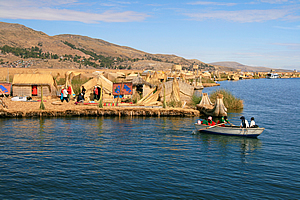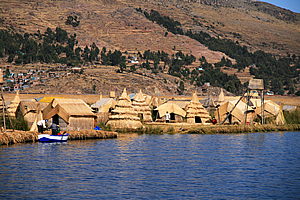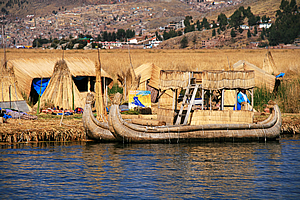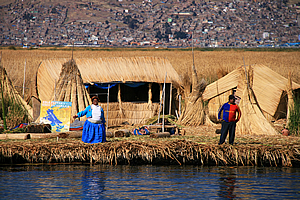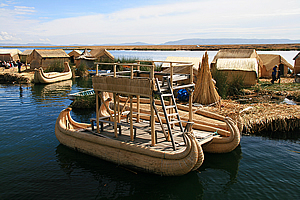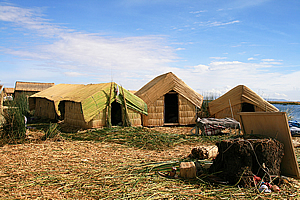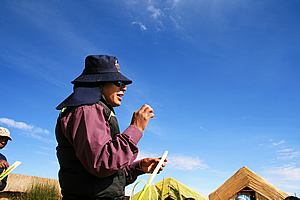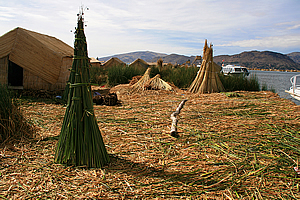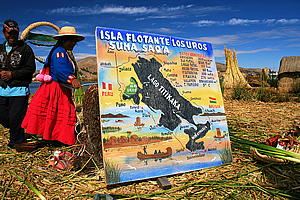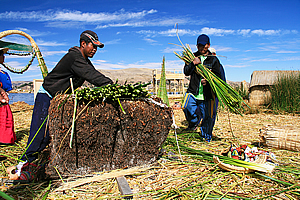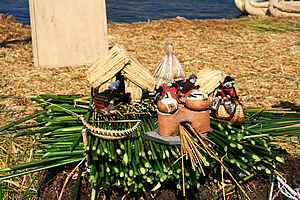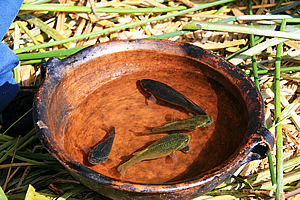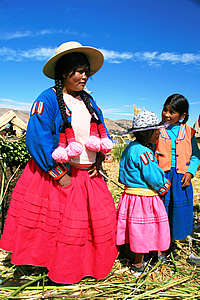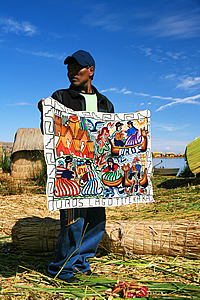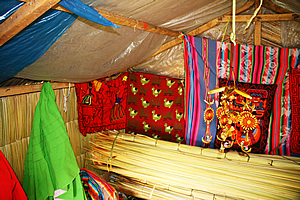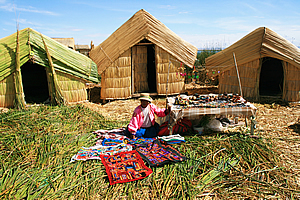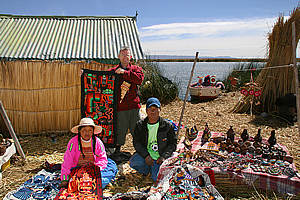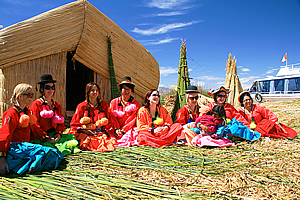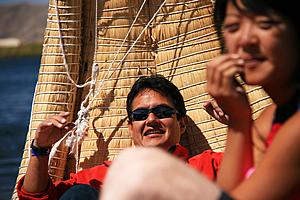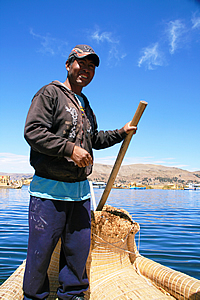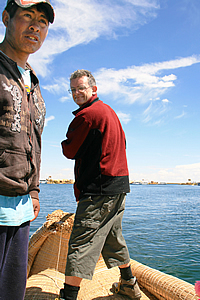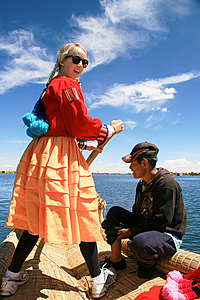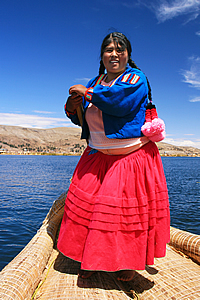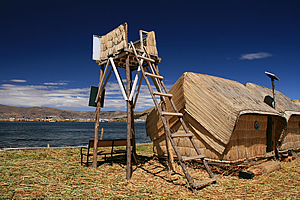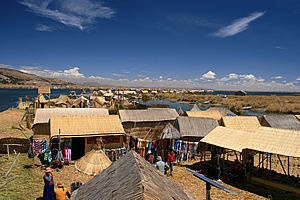--- Archive files ---
Home > Travels > Titicaca > 4 |
Floating Village of Reeds
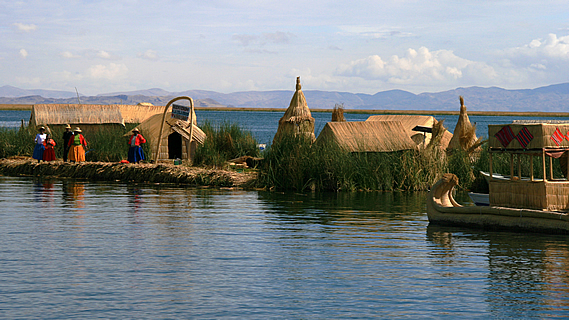
DIFFERENT cultures around the world have adapted well blending in with their natural environments as best they could to maintain a comfortable lifestyle. I wondered how people adapted to a giant lake in an alpine desert. As we approached the village, I was about to find out.
Floating village of Uros |
Near the end of the long channel, I could see the clearing in the reeds opened out into a large open area of water to a large natural channel about three hundred metres wide and several kilometres long. The village seemed to line the banks of the large channel.
We slowly approached the village, passing a leaning sign saying “Bienvenidos, A Las Islas Flotantes Los Uros” almost right at the end of the channel. I had heard stories about the legendary floating villages of Uros. Now we were here. The water we ploughed through was black and the reeds were bright orange and green under the bright blue sky. On top of the mats of reeds were entire buildings built out of more dried reeds.
Floating village of Uros |
Lake Titicaca has three populations of people living on floating reed islands. Around 4600 Uru people live in 42 different islands around the lake in three main groups. One of these (the Uru Chipayas) is in Peru, and the other two (The Uru Muratos and the Uru Iruitos) are in Bolivia.
There are about 2000 Uru Chipayas all living in the floating village that we were approaching.
The channel suddenly ended in a large tee intersection with a wide channel crossing and extending out as far as the eye could see on either side. The new channel had houses built of dried reeds and had numerous small timber structures on the floating islands on either side. They were very charming indeed, though the houses seemed very small. There were two distinctive designs. About two thirds of the houses were a small box shape, some three by three metres in size, with a gabled roof with large flaps of reed sheltering the walls. The other houses were a conical tepee shape with five layers of thatching creating four steeped rings around the huts giving a Dr Seuss look about it.
Reed boat in village |
There were also larger buildings with log pole frames thatched on the walls and roof. There were also viewing platforms some four to six metres above the bed of reeds. These were built from timber logs with thatched low walls and had a wooden log ladder going up to the viewing platform.
Standing obvious above the houses were a couple of huge fish made of reeds. Some of these were up to ten metres long and were held up by wooden poles.
Colourful villagers |
Amongst the houses were people with very dark skin and very brightly coloured clothes. Most of them had the bright red cheeks typical of people around here living at high altitude and most seemed to be very overweight. The ground around the huts was quite flat sitting about twenty centimetres above the water. There were numerous bundles of reed tied up obviously drying out to be used for future construction.
The entire settlement being built out of reeds and wood intrigued me. If this civilisation were to be abandoned everything would just rot into the lake very quickly, leaving not a trace of evidence for future archaeologists to discover. I recalled the ruins of the Inca trail where all the stone buildings still stood, but the thatched roofing had rotted away hundreds of years ago. I also recalled the huge city at Angkor Wat in Cambodia, all the crumbling stone structures that would have formed just a small part of a sprawling city at the height of the Khmer empire. All the wooden structures and houses have long rotted away only leaving the remains of the stone structures. There were no stone structures here, so this village will only last as long as it is occupied. Once abandoned the shallows of the lake will quickly revert to totora. Not a trace of this civilisation will be left after just a few short years.
Large reed boat |
There were a lot of reed boats on the water – boats made entirely of reeds eloquently shaped with bent up ends at either end with amazing craftsmanship. The larger twin hulled boats had a second level held up by wooden poles with a fenced viewing platform. Despite being made of reeds, they seemed to be very solid floating well in the calm black water.
We turned into the channel and continued for about ten minutes before stopping at one of the villages. Ten villagers were waiting for us. They were all wearing brilliant primary and secondary coloured clothing making them really stand out. There was a sign created from two bundles of reed fairly close together with a reed arch over the top with a sign hanging under is saying “Isla Flotan Losuros Suma Saqa” – the floating island of Suma Saqa. Here we climbed onto the large floating mat of weeds. It was initially difficult to walk on as it felt like walking on a waterbed. The reeds gave way slightly under our weight.
Floating village of reeds |
We sat around on logs of reeds tied up in a small U shape. Surrounding us were several small market stalls with goods spread out on large coloured blankets. Behind them stood the tiny straw huts – all of a simple square design with pitched roofs. Near me was a small ceramic bowl with four small fish in it. They had been caught in the lake and were going to be transferred to a fish pond when they are large enough.
Pablo our talkative guide showed us a few small models and clothes made from the local totora reeds. Everything here is made from the reeds. He told us about the history of the people here.
Pablo describes the village |
The Uru is a pre-Incan clan who live on forty two floating islands such as the one we were currently on. Although there are over two thousand Uru, only a couple of hundred still live on the floating islands. Most have moved to the mainland. They bury their dead in special cemeteries on the mainland. They originated on the mainland, but were kicked out forcing them to move to the islands. They had their own culture and language, but their language was lost about five hundred years ago after much intermarrying with the Aymara tribe on the mainland not long after the Inca had conquered them. The Inca had forced them to pay taxes and took many of them as slaves, causing the language and a lot of their culture to be lost.
Stacks of reed drying in the sun |
The Uru consider themselves to be the owners of the lake and the water, and respect it as such. They call themselves the Lupihaques (Sons of the Sun).
He put up a large map painted on a sheet of plywood and leaning against a large one cubic metre block of reeds. The map had the lake painted in a dark navy blue with lighter background pictures obviously painted by a professional painter. It gave all sorts of facts and figures about the lake including:
Map of the lake |
Elevation – 3809 metres above sea level.
Total area – 8560 square kilometres.
Size of lake – 150 x 60 kilometres.
Maximum depth – 274 metres.
Volume – 896,000,000 cubic metres.
Temperature – 9 degrees.
Pablo explained the lake was always cold due to the strong alpine winds that often blow here mixing the surface water with the deeper water.
Pablo along with a few of the villagers demonstrated the construction of the floating village. They took the large map away from the large block of dried out reed which had been used to hold it up. The block was about a cubic metre. The dried reed was a dark greyish brown colour. He explained that the water was about eighteen metres deep, so they built the village on a large platform of dried reeds which they demonstrated with the block. He pointed out the numerous bundles of reeds standing about three metres high in a tepee shape. Once dried the reeds are laid out over the water. Layer upon layer is built until it becomes a floating platform stable enough to walk on.
Demonstration of construction of village |
The reeds at the bottom of the raft gradually decompose into peat breaking off and sinking into the murky depths. The rotting reeds need to be replaced to ensure the platform remains afloat and stable, so a new layer is placed on top every few months. The rotting increases during the warmer summer wet season. If maintained though, the raft structure will last around thirty years. The entire structure is anchored in place with boulders tied with rope to the floating raft.
Demonstration of construction of village |
Above the platform the houses are constructed. They had perfectly scaled down model houses which they placed on the block. By now the block had two layers of fresh reed on them. The houses needed to be rebuilt every few months. They also demonstrated how the oven is constructed in the middle of each village. The oven is built on top of steel plates to ensure the reeds don’t catch alight. Dried reeds are used as the fuel for the fire.
When the Uru were banished from the mainland, they devised ways to create entire villages out of reeds. In fact they seem to use the reeds for everything. Their stomachs were tough allowing them to eat the reed. When wrapped around any injury they say the reed absorbs the pain.
Fish in a bowl |
There were a few small ponds in the reeds where they set up large nets and bred fish in them. They adapted so they could drink the water and even eat the reeds. They would not be too healthy for us though, but their stomachs had developed resistance to the toxins and bacteria in the water. They used the reeds for everything from construction to food, and even for some remedies. The base of the plant provides them with plenty of iodine to prevent goitre.
Around 2000 people come from this settlement, but most have moved to the mainland. There are only a few hundred people left here. The young children go to school on the floating islands, but older children need to attend school on the mainland. Perhaps it is there they see the opportunities outside their floating islands and decide to stay there to live and work.
Village children |
Trader selling his wares |
The dead are buried in a special cemetery on the mainland to keep the lake clean. Toileting is a challenge, but they have solved this by building tiny outhouse islands where they row to relieve themselves. Fortunately the roots of the totora are very effective in absorbing their waste keeping the lake clean. They make a kind of tea out of the reed flowers.
Inside a reed house |
We explored the village and looked at the markets. I entered one of the tiny houses. It was lined inside with clear plastic no doubt to keep it waterproof. The huts only contained rolled up bed mats (made from reeds of course) on the floor and plenty of brightly coloured clothes hanging from the ceilings. There was also a very small timber table and several large brightly coloured cushions stacked up against one of the walls.
The houses that had very recently been built were still green, but the older ones were completely straw coloured. A couple of the houses had a small solar panel to operate small electric lights, radios and televisions. The village has its own radio station that operates for several hours per day.
Market outside the houses |
Although they get a reasonable income from all the visiting tourists, the increased traffic results in much higher maintenance needed for the islands. It is therefore a tough lifestyle with the people needing to work so much harder to keep their floating island lifestyle intact.
Around the edge of the raft were a few areas of growing reed, no doubt this was part of the system to keep the raft in place. These also provided some reeds for eating and other small things without having to make a trip away from the area.
Buying at the market |
There was a large hole near one side of the great raft. I initially thought this was a place that hadn’t been constructed yet, but when I looked into it, through the bits of reed floating on the surface, there were hundreds of fish. They were confined to the pool by a large net of fine mesh in the water. The villagers do their fishing from this pond.
The lake itself is abundant in fish, with more than 530 aquatic species. Many of these species are only found here due to the lake’s isolation. There is no water access between the lake and the ocean. As well as fish they hunt seagulls, ducks and flamingos. They also domesticate birds to catch some of their fish. They also keep cats to control the rat population.
Dressing up |
The markets were just a large blanket laid out on the reeds with numerous goods on them. I bought a cloth, a small pan flute and a painted whistle from one of the markets. When they go to the mainland they barter the totora reeds for raw materials for the raw materials they use for their crafts.
Then all the ladies in the group were dressed up in the bright coloured clothes and had their hair braided too look like the villagers. They wore large brightly coloured alpaca tassels at the ends of their braids. Once all dressed up, they sat down in an arc outside one of the houses behind them as well all took photos of them. Then they stood up and waved their skirts out looking like something out of a tacky Swedish setting. Then all the guys were included in the photos.
On the boat |
We were then led to a reed boat. This was one of the smaller single hull boats because our group was quite small. It was a bit wobbly getting on board, but once we took our places and sat down we were okay. Carlos sat at the front against the prow resting like a man of leisure. One of the young guys of the village steered the boat away from the village into the channel whilst a teenage girl helped him navigate.
There were several other boats in the lake. There were several tourist boats like ours, and a number of smaller boats, mostly powered by regular oars. There was even a regular dinghy. A couple of the larger multi hulled boats had what appeared to be horse heads in their front prows.
Propelling the boat |
Propelling the boat |
I had a go at powering the boat. It was powered using a tiller going from side to side almost identically to the one the old boatsman used in the oxbow lake in the Amazon when I was there a week ago.
Propelling the boat |
Propelling the boat |
When I got the tiller, it initially felt a bit funny, but then I got the hang of it. It certainly wasn’t a fast way of moving, but then we weren’t in a hurry at all. Amanda and Amy had a go.
Lookout tower |
Finally we gave the tiller back to the locals and we continued across the dark murky green water to another village.
The new village was more elaborately set up with several shops and stalls. The main shop had a stamping service where we could have our passports stamped. Very interesting I thought, though I didn’t get mine stamped. The person in the shop was the only shop keeper I could see anywhere. Apart from our group this village was deserted. Everyone else here must be on a morning tea break.
View across the village from the tower |
Now that we were all ashore, the villagers climbed back into their reed boat and started paddling their way back to their village.
Next to the shop was a high wooden viewing platform. The framework was made from timber grown from trees on the mainland. I climbed up it to get a spectacular view of the villages along the floating lagoon. The houses were all lined up along about fifteen metres of the main channel. Beyond this it was just reeds or natural channels out towards the main lake.
I returned down to the reed floor and our boat arrived to take us further out into the lake to discover another culture living in totally different circumstances.
<< Previous | Next >> |
|
||
About this Page
|
||
|
|
|
Where is Walkabout Jeff? |
|
|
|
|
What is happening in Walkabout Jeff's hometown?
|
|
|
|
|
Who is Walkabout Jeff?Any normal person's idea of going out involves going to the local pub for a drink with a few mates. Walkabout Jeff isn't normal.
|
|
|
|
|
